Posted by James (admin) on 31st May 2013
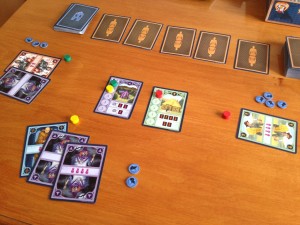 Rattus Cartus is a card game set in the world of medieval plague as is its sibling game, Rattus. It should make it clear that Rattus Cartus is not a card game version of the original Rattus game as, whilst is uses the same theme and art style, it has its own game mechanics.
Rattus Cartus is a card game set in the world of medieval plague as is its sibling game, Rattus. It should make it clear that Rattus Cartus is not a card game version of the original Rattus game as, whilst is uses the same theme and art style, it has its own game mechanics.
The goal is to earn the most victory points (VPs). At the end of the game, players score VPs based on how much influence they have with each of the 6 different character classes (10 VPs for having the most, 5Vps for 2nd most, and 2 VPs for third most influence). Some other VPs can be earned during the game too.
The game primarily comprises of character cards (6 types) and building cards (6 types each corresponding to a character). During set-up 5 random character cards are laid out face-down – each card has 0-4 nuns on it – and these are called the ‘nun’ cards. At the end of the game, any player who has more rats than the total number of nuns on these 5 cards is lost to the plague and automatically loses. Read the rest of this entry »
Tags: board game news, Board Games, board gaming, Essen, Rattus Cartus, Spiel 2012, White Goblin Games
Posted in Board Game Review, Board Games, Essen Spiel 12, Rattus Cartus | No Comments »
Posted by James (admin) on 17th May 2013
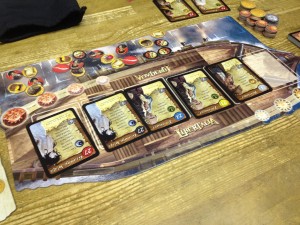 Libertalia is by Paolo Mori who designed one of my favourite games Vasco de Gama. Libertalia is a very different game to Vasco de Gama as it is a simple and relatively quick, card-playing game.
Libertalia is by Paolo Mori who designed one of my favourite games Vasco de Gama. Libertalia is a very different game to Vasco de Gama as it is a simple and relatively quick, card-playing game.
Players are pirate crews who are trying to earn the most doubloons buy collecting booty. Each player has a set of 30 cards each representing a crew member with a value (1-30), a special ability and a tie-break number. Each player’s set of cards is the same except the tie-break numbers are different so that no two cards are exactly the same. Each card’s special ability states if it will be used in the day, at dusk, at night, or at the end of the campaign. To start the 1st campaign, one player randomly draws 9 cards from their deck, then all the other players draw the same cards.
The game is played over 3 campaigns, each consisting of 6 days when players will play one card each. At the start of each campaign, booty tiles are drawn at random and placed on each of the 6 days on the board (one token per player). Most booty tokens are simply worth 1, 3 or 5 doubloons, although treasure maps are only worth 12 doubloons combined if you have at least 3 of them. There are also cursed booty tokens worth -3 doubloons, as well as saber and Spanish officer tokens which are worth no doubloons but have special effects (see below). Read the rest of this entry »
Tags: board game news, Board Games, board gaming, Libertalia, Paolo Mori, Vasco de Gama
Posted in Board Game Review, Board Games, Libertalia | No Comments »
Posted by James (admin) on 14th May 2013
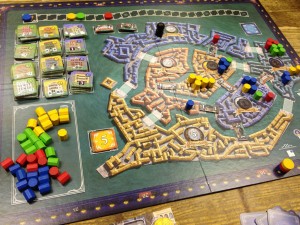 Rialto is yet another of this year’s game by Stefan Feld (which is a good thing as I like most of his games).
Rialto is yet another of this year’s game by Stefan Feld (which is a good thing as I like most of his games).
Set in Venice, Rialto is played over 6 rounds – one for each of the Venetian islands on the board. Players are aiming to score the most victory points (VPs) which are primarily earned by having councilors on the islands at the end of the game. Players each have a marker on the Doge track and this splits all ties and determines some order of play.
Each island has 1 connection to each of its 4 neighbouring islands. During the game, these 12 connections each get filled with either a bridge or a gondola token. Each bridge and gondola token has two values on it (one on each end) – bridges have values between 3-6 VPs; whereas, both values on gondolas are always value 1. This is important because the final VPs gained by players with councilmen on each island are based on the total of each island’s 4 connections’ values.
At the start of each round, several (number of players + 1) rows of cards are laid out each consisting of 6 face-up and 2 face-down cards. In Doge track order, players select one row of cards, add any extra cards they may have (such as from the previous round), and discard down to 7 cards. The player may own some buildings which allow them to have more cards to select from, or keep more than 7 cards) but players must pay 1 gold for each building used. Read the rest of this entry »
Tags: board game news, Board Games, board gaming, Rialto, Stefan Feld
Posted in Board Game Review, Board Games, Rialto | No Comments »
Posted by James (admin) on 15th March 2013
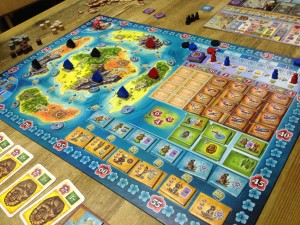 Stefan Feld’s games are known for having an interesting mechanic at their heart, which is one of the reasons I look forwards to his games. Bora Bora is no different and has a dice-placement-action system in the centre of a game that isn’t complicated but it does have a lot of other game mechanics and bits surrounding it. No specific aspect is complicated, but there is a lot going on, so I’m going to try to discuss each main part one-by-one.
Stefan Feld’s games are known for having an interesting mechanic at their heart, which is one of the reasons I look forwards to his games. Bora Bora is no different and has a dice-placement-action system in the centre of a game that isn’t complicated but it does have a lot of other game mechanics and bits surrounding it. No specific aspect is complicated, but there is a lot going on, so I’m going to try to discuss each main part one-by-one.
OVERVIEW
The game is set on a Pacific island and players place huts, gain tribe members, build buildings, make offerings to the gods, and so on. The game lasts 6 rounds and the winner is the player who finishes with the most victory points (VPs). Many VPs are earned during the game, but there are also lots of bonus VPs that can be awarded at the end of the game (although, as you’ll read later, these are quite tough to achieve).
Each round players first roll their 3 dice and then take turns placing one at a time on one of the action tiles allowing them to perform the appropriate action. Next, players use the ability of one of their man tiles and the ability of one of their woman tiles. Then, the status track (scoring VPs and determining turn order), temple track (scoring VPs and a bonus for one player) and jewelry purchases are all resolved. Finally, players must complete or discard one of their 3 objective tiles before taking a new one. (All unclaimed man and woman tiles, objectives and jewelry are cleared from the board and new ones added for the next round.) Read the rest of this entry »
Tags: board game news, Board Games, board gaming, Bora Bora, Stefan Feld
Posted in Board Game Review, Board Games, Bora Bora | No Comments »
Posted by James (admin) on 4th February 2013
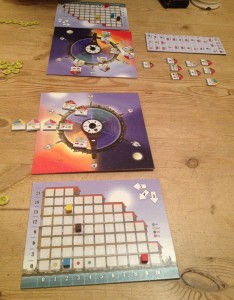 Le Havre: The Inland Port is a 2-player only game linked to the larger, original Le Havre game. I haven’t played the original Le Havre so will be reviewing this game on its own merits without comparisons. It’s a simple game with depth, but it’s also unusual so I shall explain how it plays.
Le Havre: The Inland Port is a 2-player only game linked to the larger, original Le Havre game. I haven’t played the original Le Havre so will be reviewing this game on its own merits without comparisons. It’s a simple game with depth, but it’s also unusual so I shall explain how it plays.
The Inland Port is played over 12 rounds and the winner is the player with the highest total value of cash and buildings (which each have an end-game value). Each round consists of a fixed number of actions (3 actions to start increasing to 9 actions by game’s end) and players take turns taking 1 action to either buy or use 1 building. At the start of each round, some buildings are added to the market.
Players each have two boards in front of them. One is their warehouse – a grid with 4 resource markers (clay, wood, grain, fish) where the total of each resource is the marker’s row number (multiples of three) plus the marker’s column number. When a player gains or loses resources, they move the markers in specific grid directions – this may sound unnecessary but is a clever system and I’ll explain why later.
The other player board is the main game mechanic which shows a circle divided into 6 sectors where buildings are placed once they have been bought. The circle has an arm like a clock’s minute-hand with 6 values around the part at the circle’s centre (0, 2, 3, 4, 4+1 and !) – these 6 values each match up to the circle’s 6 sectors. At the end of a round, players both advance their clock hand by one sector so the values in the centre now point at the next adjacent sector – as a result a building that was next to the zero will now be next to the 2; a building that was next to the 2 will now be next to the 3, and so on. Any building now next to the ! symbol is immediately sold for half of its value. Read the rest of this entry »
Tags: board game news, Board Games, board gaming, Le Havre: Inland Port
Posted in Board Game Review, Board Games, Le Havre: Inland Port | No Comments »
Posted by James (admin) on 1st February 2013
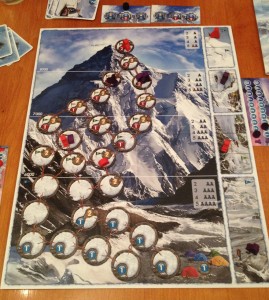 As you would expect, K2 is a game about climbing the mountain K2. Players each have two climber meeples and score points based on how high their climbers reach; however, any climbers that perish only score 1 point no matter how they had ascended.
As you would expect, K2 is a game about climbing the mountain K2. Players each have two climber meeples and score points based on how high their climbers reach; however, any climbers that perish only score 1 point no matter how they had ascended.
Each player has an identical set of 18 cards and each turn they pick 3 of the 6 cards from their hand. Cards can be climbing cards (values range from 1 to 3) or acclimatisation cards (used to increase your climbers’ health).
Once selected, all players reveal their 3 cards simultaneously. The player with the highest climbing total must take one of the 3 face-up risk tokens. These tokens range in value from 0 to 2 and the player must pay that cost with movement points, acclimatisation points, or their climbers’ health. A new token is revealed to make a total of 3 for the next round.
On their turn, players allocate each of their 3 cards to either of their climbers to move them, pitch a tent, or increase their health. If a climber’s health goes above 6, it always goes down to 6 at the end of each turn, which adds a nice limit so climbers are never too far from the chance of perishing.
Read the rest of this entry »
Tags: board game news, Board Games, board gaming, K2, Rebel.pl
Posted in Board Game Review, Board Games, K2 | 2 Comments »
Posted by James (admin) on 3rd December 2012
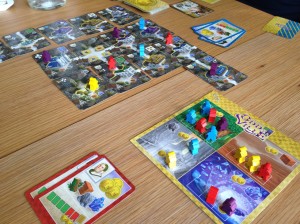
Oddville is a eurogame with a city building theme and a very compact game design. By that, I don’t mean its physical playing-size on the table; instead, I mean that the game mechanics are neatly compressed. As a result, Oddville contains a clever, inventive design with more game than you may expect from a relatively short game.
During the game player’s gain resources, money and characters as well as construct buildings so they can score the most victory points (VPs). The game ends as soon as any player places their 6th worker in the city.
Each player has their own deck of 4 action cards. On their turn, a player can play 1 action card which allows them to either gain the cash shown, or gain 1 of the resources shown, or gain 1 building from the 6 building cards on display (the card affects the price). The cards range from strong to weak and the player gets these cards back once they have used all 4, or they can spend cash to get all used ones back (but the more cards still hand, the greater the cost).
When a player chooses to gain one of the resources on their action card, they place one of their workers on the lowest market price for that resource (which are limited in number) and pays the price. The worker on the board shows the player has that resource until they spend it when building. The game scales with 2 players as there are fewer cheap resources available. Read the rest of this entry »
Tags: board game news, Board Games, board gaming, Essen, Oddville, Spiel 2012
Posted in Board Game Review, Board Games, Essen Spiel 12, Oddville | 3 Comments »
Posted by James (admin) on 30th November 2012
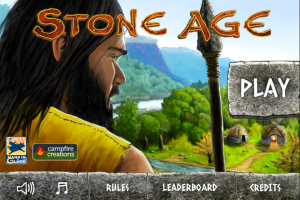
The Stone Age game app for iPhone has been submitted to Apple and should be released in December. It’s been developed by Campfire Creations and, from the screen shots so far, it looks very promising. Stone Age is one of my favourite games (definitely top 10) so I’m looking forwards to seeing how it plays.
Their press release says, “Stone Age: The Board Game will include Pass-n-Play multi-player, three AI opponents, and asynchronous or synchronous online multi-player through Game Center” which sounds great.
The press release also says, “The app will also feature a ranked League Play option for the truly competitive Stone Age players. Campfire is already developing new language support, additional AI opponents, iPhone 5 support, a universal iPad upgrade, and a variety of other features and enhancements.”
Below are some screenshots. Read the rest of this entry »
Tags: board game news, Board Games, board gaming, iPhone, Stone Age
Posted in Board Games, iPhone, On the Radar, Stone Age | No Comments »
Posted by James (admin) on 22nd November 2012
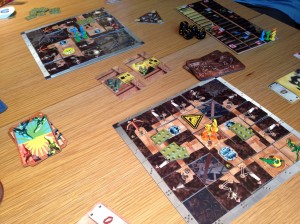 In Goblins Inc, players are goblins creating giant war robots that will fight each other. First, players are placed in random teams – these teams will change after the first fight and new robots are built by these new teams for the second (final) fight. The players who build a robot that wins a fight score victory points (VPs), plus players get individual VPs for their own hidden agenda cards. Before any building takes place, players draw 7 cards from their hidden agenda deck – just before the fight, players will choose just 4 of their 7 cards which will score them VPs once the fight is over. Hidden agenda cards award VPs based on (a) destroying specific types of tiles on the opponent’s robot, or (b) specific types of tiles not being blown off of your own robot), or (c) predicting which side will win. (Yes, you can predict the opponent to win and help it happen too). The player with the most VPs after two fights is the winner.
In Goblins Inc, players are goblins creating giant war robots that will fight each other. First, players are placed in random teams – these teams will change after the first fight and new robots are built by these new teams for the second (final) fight. The players who build a robot that wins a fight score victory points (VPs), plus players get individual VPs for their own hidden agenda cards. Before any building takes place, players draw 7 cards from their hidden agenda deck – just before the fight, players will choose just 4 of their 7 cards which will score them VPs once the fight is over. Hidden agenda cards award VPs based on (a) destroying specific types of tiles on the opponent’s robot, or (b) specific types of tiles not being blown off of your own robot), or (c) predicting which side will win. (Yes, you can predict the opponent to win and help it happen too). The player with the most VPs after two fights is the winner.
For each robot fight, players first need to build their robot by adding 20 tiles to their 5×5 grid – the centre space is always the cockpit and 4 spaces (determined by a card each fight) must remain empty. Tiles show engines, weapons, decorations and armour, plus they also show the underlying bodywork too. When building, you can place tiles on any empty grid space; however, if any tile is not contiguously connected by bodywork before the fight starts then it will fall off. Read the rest of this entry »
Tags: board game news, Board Games, board gaming, Essen, Goblins, Spiel 2012
Posted in Board Game Review, Board Games, Essen Spiel 12, Goblins | No Comments »
Posted by James (admin) on 20th November 2012
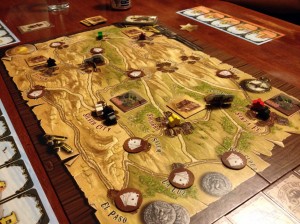 In Desperados, one player is the marshal trying to protect the Wild West from the other players who are all outlaws working together to rob banks, fix poker games and hold-up stage coaches. If the outlaws can gather a total of $4,000 for each outlaw player after 5 rounds, the outlaws win.
In Desperados, one player is the marshal trying to protect the Wild West from the other players who are all outlaws working together to rob banks, fix poker games and hold-up stage coaches. If the outlaws can gather a total of $4,000 for each outlaw player after 5 rounds, the outlaws win.
The gameplay uses an interesting hidden-movement game mechanic as the outlaws try to move to where the sheriffs and marshal are not located so they can steal money and avoid being arrested. (I’ll explain the game mechanic in a bit of detail as it’s the core of the game – it’s actually simple but requires careful explanation.)
GAMEPLAY
The board shows various towns and cities connected by roads – towns have poker game tiles (worth $300-$600), cities have bank tiles (worth $500-$3,200), and stagecoaches move to towns and cities along pre-determined routes (worth $800-$1,200 when robbed). Note that the tiles are random and values hidden so outlaws don’t know exactly what they’re worth.
Wooden figures on the board (meeple) show the locations of each outlaw, the marshal and the sheriffs (1 sheriff per outlaw player). Each outlaw and marshal player has a deck of cards: 1 card showing each town/city plus 1 saloon card. Each of the 5 rounds is split into a planning phase followed by an evaluation phase. Read the rest of this entry »
Tags: board game news, Board Games, board gaming, Desperados, Essen, Spiel 2012
Posted in Board Game Review, Board Games, Desperados, Essen Spiel 12 | 2 Comments »
 Rattus Cartus is a card game set in the world of medieval plague as is its sibling game, Rattus. It should make it clear that Rattus Cartus is not a card game version of the original Rattus game as, whilst is uses the same theme and art style, it has its own game mechanics.
Rattus Cartus is a card game set in the world of medieval plague as is its sibling game, Rattus. It should make it clear that Rattus Cartus is not a card game version of the original Rattus game as, whilst is uses the same theme and art style, it has its own game mechanics.









